Building Integrated Photovoltaic Systems
Acronym of BIPV (Building Integrated Photovoltaics) refers to photovoltaic systems
integrated within an object. It means that such systems are built/constructed along
with an object. Yet, they could be built later on. Due to specific task cooperation
of many different experts, such as architects, civil engineers and PV system
designers, is necessary. According to how and where such systems are built,
whether integrated into the facade or in the roof, the following BIPV systems are recognized:
Facade or roof systems added after the building was built,
Facade integrated photovoltaic systems built along with an object,
Roof-integrated photovoltaic systems built along with an object,
Shadow-Voltaic PV systems also used as shading systems.
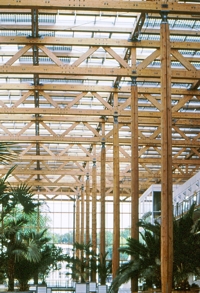
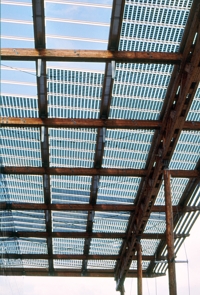
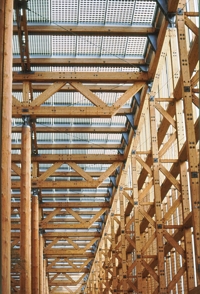
Akademie-du-Mont-Cenis, Herne, Germany, PV system integrated into building envelope
image credit: pvresources
In the case of facade or roof systems the photovoltaic system is added to the building after it was built. These low powered systems of up to some 10 kW are usually integrated into the south facade. Facade integrated photovoltaic systems could consist of different transparent module types, such as crystalline and micro-perforated amorphous transparent modules. In such case a part of natural light is transferred into the building through the modules. Solar cells are available in different colours; therefore, there is no limitation for imagination of the architect or the designer. We can say that such constructed buildings give the term architecture a completely new meaning. Roof-integrated photovoltaic systems are integrated into the roof; the roof is covered with transparent photovoltaic modules, or they are added to the roof later. Such systems are added to a flat roof, or on a tilted roof usually only if the building is small. It is possible to use tiles, which integrate solar cells.
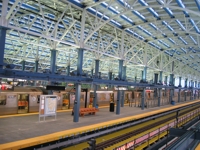
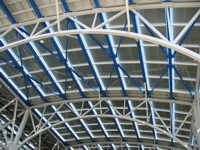
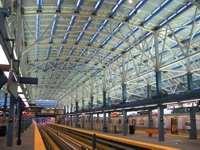
Train station Stillwell Avenue, New York City, roof integrated transparent BIPV system
image courtesy: Arnold Glas
Photovoltaic systems can be used for shading, where photovoltaic modules serve as Venetian blinds. In some of such cases photovoltaic modules tilt angle can be adjusted manually or automatically allowing photovoltaic module and/or building shading efficiency optimization. Such systems are also known as shadow-voltaic systems. The best results and efficiency can be reached with systems, which are tightly integrated into the building's envelope; however, the use of active solar systems is an additional possibility. High level of expertise is required for successful BIPV systems planning, not only in regard to architecture, but also to civil and photovoltaic engineering. The projects realised in the past show that successful BIPV systems designing is based heavily on technical experience and knowledge. Poorly designed systems usually have to be redesigned or repaired later, consequently swelling maintenance costs and lowering system efficiency rate.
Modules in BIPV Applications
In BIPV applications different types of modules (depends on application) can be used: classic (framed) modules, flexible crystalline or thin-film on metal substrate, roof-tiles with solar cells, transparent monocrystalline modules, modules with coloured solar cells, semitransparent micro perforated amorphous etc. Upon customer request almost all module (mechanical and electrical) parameters can be customized. Customization include module shapes, cell type and colour, cell transparency, laminate construction, laminate/module size, heat/noise isolation properties, module voltage and peak power etc. Module size is limited by laminator features - largest laminators allow production of laminates up to 5 square meters of area in one piece. Exact shading analysis should be made before the system is constructed, high temperature conditions should be avoided if crystalline modules are used (decreased efficiency). Most common realized as curtain wall, or facade mounted modules. Cold and warm photovoltaic facades possible. In BIPV facades different types of modules can be used: classic modules, transparent or semitransparent modules (crystalline or microperforated amorphous modules). Shadow-Voltaic system is also very often part of a BIPV facade. Modules can be fixed or mounted on tracking structures - manual tracking-combined with shadowing system, or automatic tracking systems possible.

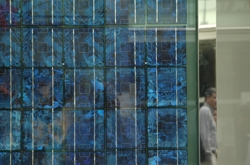
Facade integrated solar modules in Cologne, Germany
image courtesy: Architekturbüro Hagemann
Solar Glazings
In photovoltaic applications (also in BIPV systems) low iron tempered glass is usually used. Glazing can be made as simple glass/glass laminate or as complex isolation glass/glass laminate. Special laminates with coloured back sides have also been produced. Due to safety requirements for lamination usually PVB foil instead of EVA foil is used - especially for laminates used in transparent roofs. PVB have been used for decades in automotive industry - laminated safety windscreen glass. Laminate can consist of monocrytalline cells, thin film cells or from transparent cells. For details please see transparent solar cells and modules section or module section.
BIPV Projects and Sollutions
Solar Design Associates - Solar Design Associates (SDA) is North America's oldest, largest, and most respected building design firm dedicated to the artistic integration of solar energy in homes and buildings.
Architects
Architekturbüro Hagemann - since 1991, Architects and Consultants working in the field of BIPV.
Rolf Disch - Rolf Disch Solar Architecture commands an immense amount of experience in not only housing and community building, but as well in planning commercial, office, hotel and exhibition space – and last but not least social institutions.
BEAR Architecten - group of Architects with many BIPV and sustainable buildings projects realized worldwide.
KISS + Cathcart Architects - Since 1983, US architects Kiss + Cathcart has been designed successfully operating BIPV systems.
Other Commercial Available BIPV Products
American Warming and Ventilating - fixed or controllable Shadovoltaic external glazed solar shading system that may be installed either vertically or horizontally in front of the facade.
Colt International - fixed or controllable external solar shading systems.
LOF Solar - LOF SOLAR Corp. produces coloured solar cells in variety of shapes and colours.
Books
|
|
Commission of the European Communities. 1993. Solar Architecture in Europe. Prism Pr Ltd. ISBN 978-1853270734. |
|
|
Gaiddon, Bruno, Henk Kaan and Donna Munro. 2009. Photovoltaics in the Urban Environment: Lessons Learnt from Large Scale Projects. London: Earthscan. ISBN 978-1-84407-771-7. |
|
|
Hagemann, Ingo. 2002. Gebäudeintegrierte Photovoltaik: Architektonische Integration der Photovoltaik in die Gebäudehülle; Köln: Rudolf Müller. ISBN 3-481-01776-6. |
|
|
Krippner, Roland (ed.). 2016. Gebäudeintegrierte Solartechnik. München: Institut füinternationale Architektur-Dokumentation. ISBN 978-3-95553-325-0. |
|
|
Prasad, Deo and Mark Snow. 2005. Designing with Solar Power: A Source Book for Building Integrated Photovoltaics (BIPV). London: Earthscan. ISBN 1-844071-47-2. |
|
|
Roberts, Simon and Nicolò Guariento. 2009. Building Integrated Photovoltaics, a Handbook. Basel: Birkhäuser. ISBN 9783764399481. |
|
|
Schneider, Astrid. 1996. Solararchitektur für Europa. Basel: Birkhäuser. ISBN 978-3764353810. |
|
|
Sick, Friedrich and Thomas Erge. 1996. Photovoltaics in Buildings: A Design Handbook for Architects and Engineers. IEA SHC, Task 16 - Photovoltaics in Buildings. London: James&James. ISBN1 873936 59 1. |
|
|
Weller, Bernhard, Claudia Hemmerle, Sven Jakubetz and Stefan Unnewehr. 2012. Photovoltaik, Technik, Gestaltung, Konstruktion. München: Institut füinternationale Architektur-Dokumentation. ISBN 978-3-920034-25-6. |
Reports
|
|
Designing Photovoltaic Systems for Architectural Integration - IEA SHC Task 41, Subtask A: Criteria for Architectural Integration. |
|
|
Building Integration of Solar Thermal and Photovoltaics - Barriers, Needs and Strategies - IEA SHC Task 41, Subtask A: Criteria for Architectural Integration. |
|
|
Solar Energy Systems in Architecture - Integration Criteria and Guidelines - IEA SHC Task 41, Subtask A: Criteria for Architectural Integration. |
|
|
Eiffert, P., Kiss, G.J.: Building-Integrated Photovoltaic; Designs for Commercial and Institutional Structures - A Sourcebook for Architects. |
|
|
Kiss, G.J., Kinkead, J. (1996), Optimal Building-Integrated Photovoltaic Applications - Kiss + Company Architects, 1996. |
|
|
Eiffert, Patrina. 2003. Building Integrated Photovoltaic Power Systems Guidelines for Economic Evaluation; January 2003, NREL/TP-550-31977. |
|
|
Potential for Building Integrated Photovoltaic; Report T7-04 IEA PVPS Task 7, 2002. |
|
|
Schoen, T.J.: Building-Integrated PV installations in The Netherlands: examples and operational experiences; IEA PVPS Task 7, Photovoltaic Power Systems in the Build Environment. |
|
|
Zondag, H., Bakker, M., van Helden, W. editors: PVT ROADMAP, A European guide for the development and market introduction of PV-Thermal technology; PV Catapult project, supported by the European Union under contract no. 502775 (SES6). |
Papers
|
|
Jelle, P. et al. (2012), Building Integrated Photovoltaic Products: A State-of-the-Art Review and Future Research Opportunities, Solar Energy Materials & Solar Cells, 100, 69-96. |
|
|
Jelle, P., Breivik, C. (2012), The Path to the Building Integrated Photovoltaics of Tomorrow, Energy Procedia, Volume 20, 2012, Pages 78-87. |
|
|
Jelle, P., Breivik, C. (2012), State-of-the-art Building Integrated Photovoltaics, Energy Procedia, Volume 20, 2012, Pages 68-77. |
|
|
Kaan, H., Reijenga, T. (2004), Photovoltaics in an architectural context, Progress in Photovoltaics: Research and Applications, Volume 12, Issue 6, pages 395-408, September 2004. |
|
|
Hagemann, I. (2004), Examples of successful architectural integration of PV: Germany, Progress in Photovoltaics: Research and Applications, Volume 12, Issue 6, pages 461-470, September 2004. |
|
|
Ohno, J. (2004), Examples of successful architectural integration of PV: Japan, Progress in Photovoltaics: Research and Applications, Volume 12, Issue 6, pages 471-476, September 2004. |
|
|
Prasad, D, Snow, M. (2004), Examples of successful architectural integration of PV: Australia, Progress in Photovoltaics: Research and Applications, Volume 12, Issue 6, pages 477-483, September 2004. |
|
|
Schoen, T. et al. (1997), Large-scale Distributed PV Projects in The Netherlands, Progress in Photovoltaics: Research and Applications, Volume 5, Issue 3, pages 187-194, May/June 1997. |
|
|
Ropp, Michael, E. et al. (1997), Design Considerations for Large Roof-integrated Photovoltaic Arrays, Progress in Photovoltaics: Research and Applications, Volume 5, Issue 1, pages 55-67, January/February 1997. |
|
|
Hagemann, I., (1996), Architectural considerations for building-integrated photovoltaics, Progress in Photovoltaics: Research and Applications, Volume 4, Issue 4, pages 247-258, July/August 1996. |
|
|
Kiss, G., (1996), The PV infrastructure: Architecture from houses to highways, Progress in Photovoltaics: Research and Applications, Volume 4, Issue 4, pages 259-268, July/August 1996. |
|
|
Abbate-Gardner, C. (1996), Open public spaces and street furniture: the potential for increased use of photovoltaics in the built environment, Progress in Photovoltaics: Research and Applications, Volume 4, Issue 4, pages 269-277, July/August 1996. |
|
|
Reijenga, T. H. (1996), Photovoltaics in architecture in The Netherlands: an architect's view, Progress in Photovoltaics: Research and Applications, Volume 4, Issue 4, pages 279-294, July/August 1996. |
Additional Information
|
|
Astrid Schneider - solar architect, web site with many interesting BIPV examples. |
|
|
Innovative solar products for building integration - IEA SHC - Task 41: Solar Energy & Architecture. |
|
|
The International Building Performance Simulation Association, IEA PVPS - Task 7, Reports. |
|
|
The International Building Performance Simulation Association, IPBSA is a non-profit international society of building performance simulation researchers, developers and practitioners. |
Other
|
|
Take a tour trough the Maine Solar House; design, solar energy use etc. |
|
|
Improving the world through passive solar homes, plans, and solar concepts, TheSolarPlan.com. |

